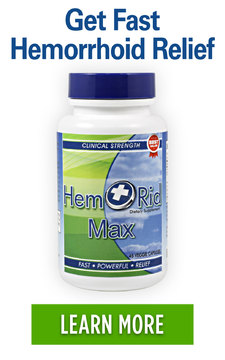Best Exercises for Hemorrhoids - Use Kegel, Pilates, and Yoga Exercises for Hemorrhoids
Posted on 07 July 2018 by Maryanne Johnson
Share this post
Are you looking for the Best Exercises for Hemorrhoids? Maybe you have faced hemorrhoids several times and are an expert at treating them through home remedies, or perhaps you are new to the hemorrhoid disease and are searching for ways to prevent these annoying hemorrhoid flare-ups.
Either way, there are natural methods that can help subside hemorrhoids and get you back on track for a healthier, hemorrhoid-free lifestyle.
Hemorrhoids and exercise have a complicated relationship, and at times, it can be contradictory. Certain exercises can immensely help prevent hemorrhoids and treat their symptoms, but other forms of exercise can make them worse.
Hemorrhoids are inflamed veins inside the rectum and underneath the skin around the anus. Depending on which location the inflammation occurs determines which type of hemorrhoid you have, either internal or external.
How Exercise or Pressure Affects Hemorrhoids
Excessive pressure on the pelvic floor muscles, either from heavy lifting, pregnancy or from being overweight, can cause hemorrhoid inflammation. Straining and constipation are also sustainable reasons for hemorrhoidal swelling.
Sometimes, doctors will recommend their patients to avoid strenuous activities to avoid upsetting hemorrhoid conditions or to prevent a flare-up.
Walking, jogging, and other exercises that can get the blood flowing are advised, whereas anything that would induce further swelling is not.
If you have a job that requires frequent heavy lifting, then it’s natural that you may experience hemorrhoids and hemorrhoid symptoms because of it. Heavy lifting, weightlifting, pregnancy, and childbirth are all contributors to hemorrhoids.
Kegel Exercises for Hemorrhoids
There are exercise techniques that are designed to reduce the chance of getting hemorrhoids, and these are recommended for people who have reoccurring hemorrhoids or face additional pressure on their rectal veins, for example, pregnancy.
Kegel exercises are designed to strengthen pelvic floor muscles, which in turn can help rectal veins resist inflammation and thereby, hemorrhoids and their similar symptoms.
Since the early 1950s, pelvic floor muscles have been researched, studied, and brought into treatments for dysfunctions of the urinary tract, pregnancy issues, and even hemorrhoids.
Introduced by gynecologist Arnold Kegel, Kegel exercises have a long history of being used as an effective means to regain pelvic floor muscle strength, preventing health issues such as prolapse, relieving hemorrhoids, and urinary incontinence.
Performing Kegel exercises, especially for pregnant women, can immensely reduce hemorrhoid episodes and symptoms.
To do a Kegel exercise, repeatedly contract and relax your pelvic floor muscles. You can do Kegel exercises multiple times throughout the day, or as much as desired. The action of contracting and relaxing your pelvic floor muscles will tone them, and this includes strengthening your anal muscles.
Kegel exercises have the similar effect of other exercises in that it promotes circulation. Healthy circulation in the rectal veins can deter them from swelling, which is otherwise known as hemorrhoids.
Swollen rectal veins can form internal or external hemorrhoids. By doing multiple repetitions of Kegel exercises throughout the day, you can help reduce hemorrhoid symptoms and make them more manageable. Kegel exercises are safe to do, even if you already have hemorrhoids.
Pelvic Floor Exercises for Hemorrhoids
Aside from Kegel exercises, there are other similar forms of activities you can perform to strengthen and enhance your pelvic floor muscles. By doing so, your body will have better control over rectal veins, an excellent and helpful practice to prevent them from swelling and causing painful hemorrhoids.
Pilates introduces pelvic floor exercises, specifically targeted for women, especially those who are pregnant or are postpartum. Men also can perform pelvic floor muscle exercises. This is helpful for both genders that struggle with hemorrhoids, bladder control, and other urinary or rectal issues.
For women, hemorrhoids are more common during pregnancy due to the growing uterus straining and placing pressure on rectal veins and blood vessels. The same is true for vaginal delivery, as labor consists of intensive straining and pushing in which hemorrhoids can become inflamed.
Yoga is also instrumental in strengthening the pelvic floor muscles, with certain positions aimed at contracting and relaxing these muscles to encourage the body’s circulation. As an added benefit, doing yoga has a corresponding positive effect on stress levels. Many people perform yoga for its meditative principles that aid in both mental, emotional, and physical health.
In concern with hemorrhoids, too vigorous or strenuous of physical activity can worsen symptoms and prolong a flare-up.
With yoga, Pilates, or Kegel exercises, you can promote the normal functionality of these rectal veins while avoiding factors that cause them to swell.
- Mountain Pose is a position that can work the pelvic floor muscles with the additional use of a yoga brick. In a standing position, use the strength of your inner thighs to lift the yoga brick.
- Chair pose is a yoga position that engages the pelvic floor muscles. Beginning in a standing position, also known as Mountain Pose, perform a squat like motion that is similar to sitting in an invisible chair. You should feel these muscles worked each time you stand back up.
- Happy Baby Pose involves lying on your back and raising your feet towards your head, with your knees touching your chest. This action stretches the pelvic floor, bolstering the muscles and collection of veins.
- Warrior Pose mirrors that of a lunge and like a Kegel exercise, actively works to make the pelvic floor muscles tighten. By holding this pose for half of a minute, you can fortify these muscles.
A few approaches for pelvic floor muscles include:
- Tightening the thighs, buttocks, and abdomen, drawing the pelvic floor muscles closer. Try completing 15 slow "squeezes" and following with 15 fast "squeezes."
- Squats are helpful in tightening and strengthening pelvic floor muscles. Complete a set of 10 squats three times a day while maintaining the proper form.
- Find and identify your pelvic floor muscles. In a repetitive contracting motion, hold your pelvic muscles while ensuring you are not tightening any surrounding muscles for about ten full seconds, then relaxing.
Kegel exercises can be complete discreetly throughout the day with no one but yourself knowing you are engaging them. Kegel exercises can be achieved even in a sitting or lying position throughout the day, as many times as desired.
Because many pregnant women are prone to hemorrhoid flare-ups, these methods in reducing the occurrence of hemorrhoids and symptoms are safe and allow for a lowered risk of physical activity during pregnancy and the painful postpartum period.
If you are pregnant and struggling with hemorrhoids, talk to your doctor about these forms of exercise as a means to prevent the occurrence of hemorrhoids and to lessen the symptoms.
Take Care of Your Body for Hemorrhoid Prevention
Physical activity is a double-edged sword for hemorrhoids; while it can help, you have to find the right one. Hardier physical exercises such as weightlifting, challenging runs, and arduous sports can make hemorrhoids worse.
Be careful when weightlifting or running with hemorrhoids. Both of these exercises can aggravate your hemorrhoids and make matters worse.
But by practicing Kegel exercises, Pilates, yoga, and even squats, you can safely fortify your pelvic floor muscles without your hemorrhoids erupting in swelling and symptoms of itching or burning.
Performing these exercises while coupling various treatment methods can be a useful approach in subsiding frequent hemorrhoid flare-ups.
When discussing your hemorrhoidal condition with your doctor, he or she may advise an additional supplement that can complement your diet to curb flare-ups.
Hemorrhoid pills are a great way to get natural, herbal relief.
Many initial treatments for hemorrhoids will include a fiber supplement or fiber gummy and the advice to seek fiber in whole natural foods.
Fruits, beans, nuts, and vegetables are fibrous, but when this is not enough, hemorrhoids will occur. A fiber supplement bridges the gap between recommended fiber intake and the amount consumed by the patient.
Doctors commonly recommend stool softeners to patients with mild to moderate hemorrhoid symptoms. A stool softener will bulk stools, increasing their moisture contents, which in turn, makes them easier to pass.
Ultimately, the goal in eliminating hemorrhoids is to implement ways to avoid inflaming these sensitive rectal veins. Kegels and like-minded exercises will aid in bolstering pelvic floor muscles, thereby promoting functionality of the rectal veins and piles, while a fibrous diet will prevent constipation, straining, and subsequently, rectal vein inflammation.
Don't forget to try our #1 hemorrhoid supplement, called HemRid Max.
By establishing these various means and methods, you can actively reduce the severity of hemorrhoid symptoms and achieve normalcy in the rectal veins to prevent hemorrhoids from forming internally and externally.







0 comments